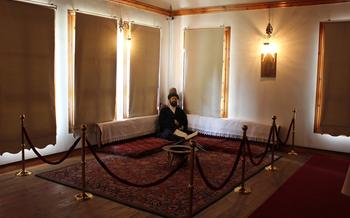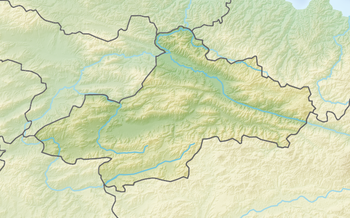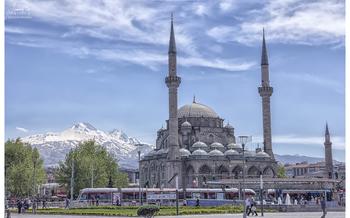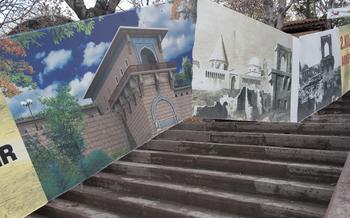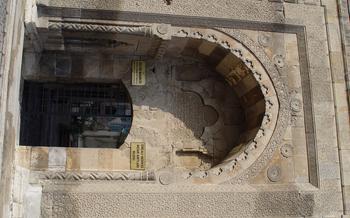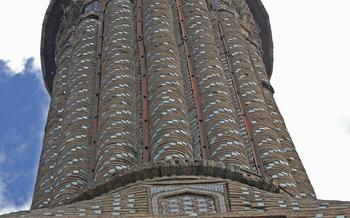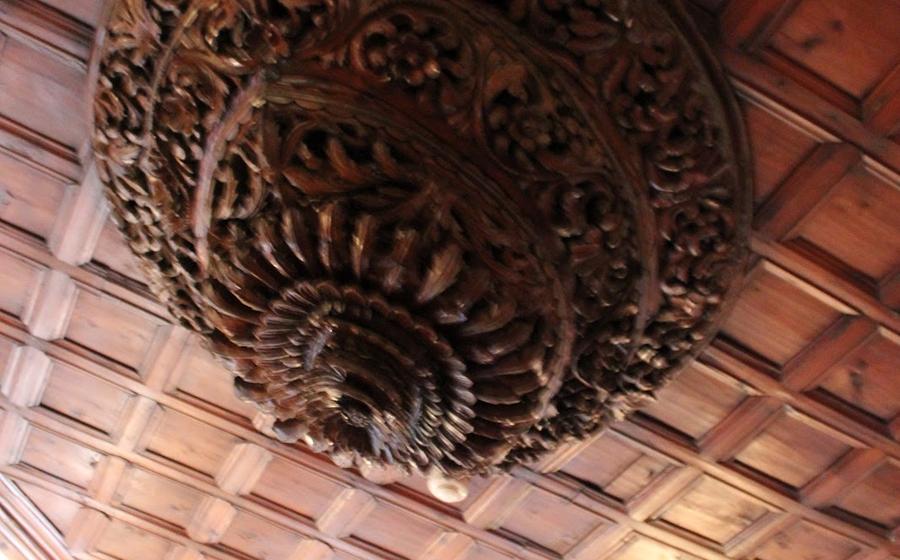
Erbalı Kümbetleri (The Tombs of Erbali)
- Erbalı Kümbetleri: A Historical Overview
- Location and Getting There
- Exploring the Tombs
- Historical Context
- Architectural Significance
- Cultural Importance
- Visiting Tips
- Nearby Attractions
- Accommodation Options
- Insider Tip: The Best Time to Book Accommodation for the Best Rates
- Guided Tours and Local Guides
- Accessibility and Facilities
- Safety and Security
- Photography and Videography
- Insider Tip: Hidden Gem
Erbalı Kümbetleri: A Historical Overview
The Erbalı Kümbetleri, also known as the Tombs of Erbali, are a group of five mausoleums located in the city of Tokat, Turkey. These stunning structures, dating back to the 13th century, are considered masterpieces of Seljuk architecture and offer a glimpse into the rich history and cultural heritage of the region.
The tombs were commissioned by the Seljuk Sultan Alaeddin Keykubad I and built by his vizier, Şemseddin Altunbaş. The mausoleums are constructed of cut stone and feature intricate carvings and inscriptions that showcase the exceptional craftsmanship of the Seljuk artisans. Each tomb has a unique design, reflecting the diverse architectural influences that shaped Anatolian architecture during this period.
The Erbalı Kümbetleri hold significant historical importance as they represent the transition from the Seljuk to the Ottoman era. They served as burial places for members of the Seljuk royal family and high-ranking officials, symbolizing the power and prestige of the Seljuk dynasty.
In addition to their architectural and historical significance, the Erbalı Kümbetleri played a crucial role in the development of Anatolian architecture. Their innovative designs and construction techniques influenced subsequent architectural styles and set the stage for the emergence of the Ottoman architectural tradition.
A local legend associated with the tombs adds to their mystique. It is said that a young princess, who was deeply in love with a commoner, was forbidden from marrying him. In her grief, she locked herself in one of the tombs and took her own life. Since then, it is believed that her spirit haunts the tombs, waiting for her beloved.
Location and Getting There
The Erbalı Kümbetleri are located in the village of Erbaa, approximately 15 kilometers southeast of the city of Tokat. To reach the tombs, you can take a bus from the Tokat bus station to the Erbaa town center. From there, you can either take a taxi or walk the remaining distance to the tombs. If you're driving, take the Tokat-Sivas highway and follow the signs to Erbaa. The tombs are well-signposted and easy to find.
Insider Tip: The best time to visit the tombs is early in the morning or late in the afternoon to avoid the midday heat.
Exploring the Tombs
The Erbalı Kümbetleri complex comprises four tombs, each showcasing intricate architectural features and inscriptions that tell the stories of their occupants. The first tomb, known as the Çukur Kümbet (Pit Tomb), stands out for its unique design. It features a sunken chamber that can be accessed via a narrow staircase, leading visitors into a subterranean realm filled with historical intrigue.
The second tomb, called the Kesik Minareli Kümbet (Minaretless Tomb), is notable for its unfinished minaret. The minaret, which was intended to be a symbol of religious devotion, remains incomplete, leaving visitors to ponder the reasons behind its unfinished state.
The third tomb, known as the Uzun Minareli Kümbet (Long Minaret Tomb), boasts the tallest minaret among the four tombs. Its slender minaret rises towards the sky, providing panoramic views of the surrounding landscape.
The fourth tomb, called the Sivri Kümbet (Pointed Tomb), is distinguished by its conical roof. This unique architectural feature sets it apart from the other tombs and adds to the overall diversity of the Erbalı Kümbetleri complex.
The tombs feature beautiful carvings and inscriptions that provide insights into the lives and legacies of the individuals buried within. Visitors can admire the intricate designs, calligraphy, and verses from the Quran that adorn the walls and doorways.
Each tomb holds the remains of important figures from the Seljuk period, including religious leaders, scholars, and military commanders. Visitors can learn about the contributions and achievements of these individuals, gaining a deeper understanding of the rich history and cultural heritage of Tokat.
Anecdote:
During the restoration efforts of the Erbalı Kümbetleri, a fascinating discovery was made. While cleaning the interior of one of the tombs, workers uncovered a hidden chamber beneath the floor. Inside, they found a collection of ancient manuscripts and artifacts that shed new light on the lives of the individuals buried in the tomb. This discovery highlighted the importance of preserving and studying these historical sites to uncover the secrets they hold.
Historical Context
The Erbalı Kümbetleri stand as testaments to the rich history of the Seljuk Empire, which played a pivotal role in shaping the cultural and architectural landscape of Anatolia. During the 13th century, the Seljuks, a Central Asian dynasty, established a vast empire that encompassed much of the Middle East and Anatolia. Under their rule, Anatolia experienced a remarkable transformation, marked by the synthesis of Islamic and Byzantine architectural traditions.
The Seljuk Empire's influence on Anatolian architecture was profound. The Seljuks introduced new architectural forms and techniques, blending them with existing Anatolian traditions to create a unique style. This fusion of influences is evident in the Erbalı Kümbetleri, which showcase a harmonious blend of Islamic and Byzantine elements. The tombs' octagonal shape, intricate carvings, and use of glazed tiles are all testaments to the Seljuk Empire's architectural prowess.
Beyond their architectural significance, the Erbalı Kümbetleri hold historical importance as they are closely associated with the Seljuk funerary tradition. In the Seljuk Empire, tombs were often built as monumental structures to honor and commemorate deceased rulers and their families. The Erbalı Kümbetleri exemplify this tradition, serving as resting places for notable Seljuk figures.
Throughout history, the tombs have witnessed numerous historical events and have been visited by prominent figures. One notable account speaks of a visit by the famous traveler Evliya Çelebi, who in the 17th century described the tombs in his travelogue, "Seyahatnâme." Çelebi's writings provide valuable insights into the historical significance of the Erbalı Kümbetleri and their role in the Seljuk funerary tradition.
Architectural Significance
The Erbalı Kümbetleri stand as remarkable examples of Seljuk architecture, showcasing unique features that set them apart from other structures of the period. Their distinct octagonal shape, a departure from the traditional square or rectangular mausoleums, adds a touch of elegance and sophistication to their design. The intricate brickwork and stone carvings adorning the tombs further enhance their visual appeal, creating a captivating interplay of light and shadow.
One of the most striking features of the Erbalı Kümbetleri is their intricate carvings and inscriptions. These decorative elements not only add aesthetic value but also hold historical and cultural significance. The carvings depict various motifs, including geometric patterns, vegetal designs, and stylized human figures, reflecting the artistic prowess of the Seljuk artisans. The inscriptions, often in Arabic script, provide valuable insights into the lives and achievements of the individuals buried within the tombs, serving as historical records of the past.
The Erbalı Kümbetleri also exhibit a harmonious blend of Islamic and Byzantine architectural influences. The octagonal shape and the use of domes are reminiscent of Islamic architecture, while the intricate carvings and decorative elements bear similarities to Byzantine art. This fusion of architectural styles reflects the cultural diversity and artistic exchange that took place during the Seljuk period, resulting in a unique and visually stunning architectural style.
Anecdote:
During my visit to the Erbalı Kümbetleri, I was particularly drawn to the exquisite carvings that adorned the exterior of the tombs. As I traced the intricate patterns with my fingers, I couldn't help but marvel at the skill and artistry of the Seljuk craftsmen. Each line and curve seemed to tell a story, capturing the essence of a bygone era. The beauty and precision of the carvings left an indelible impression on my mind, reminding me of the rich architectural heritage that Turkey possesses.
Cultural Importance
The Erbalı Kümbetleri hold immense cultural significance, embodying the essence of Turkish heritage and tradition. These tombs stand as testaments to the rich history and artistic achievements of the Seljuk Empire, showcasing the intricate blend of Islamic and Byzantine influences. Over the centuries, the tombs have become deeply embedded in the local culture, serving as sources of inspiration for artists, writers, and poets.
Their enduring legacy is reflected in the numerous festivals and events held in Tokat, which often incorporate elements inspired by the tombs' architecture and history. These celebrations, steeped in tradition, bring the community together and showcase the vibrant cultural heritage of the region. The tombs' significance extends beyond their physical presence; they are woven into the fabric of Turkish identity, representing a deep sense of pride and cultural belonging.
Anecdote:
In the heart of Tokat, a renowned local artist named Ayşe drew inspiration from the Erbalı Kümbetleri's intricate carvings and majestic presence. Captivated by their timeless beauty, she embarked on a journey to capture their essence through her vibrant paintings. Her artwork, infused with the spirit of the tombs, became a testament to the enduring cultural legacy of this remarkable site, captivating audiences with its intricate details and profound emotional resonance. Ayşe's creations not only showcased her artistic talent but also highlighted the profound impact of the tombs on the local artistic community.
Visiting Tips
When planning your visit to the Erbalı Kümbetleri, it's essential to consider a few practical tips for a smooth and enjoyable experience:
-
Recommended Duration: Dedicate at least an hour to thoroughly explore the tombs and appreciate their architectural details. This duration allows you to take your time, read the inscriptions, and soak in the historical ambiance.
-
Dress Code: Respect the religious significance of the site by dressing modestly. Avoid revealing clothing and opt for comfortable attire suitable for walking and exploring an outdoor historical site.
-
Photography Guidelines: Photography is generally permitted at the Erbalı Kümbetleri, but using a flash is prohibited to preserve the integrity of the tombs. Tripods are allowed, but using them responsibly is important to avoid obstructing other visitors' views.
-
Insider Tip: Best Angle for Photos: For the most captivating shots, position yourself at a slight distance from the tombs to capture their grandeur against the backdrop of the surrounding landscape. This angle provides a panoramic perspective that showcases the tombs' architectural features and their harmonious relationship with the natural environment.
Nearby Attractions
Beyond the tombs, Tokat offers a treasure trove of historical and natural wonders. Explore the Tokat Kalesi, a majestic castle perched atop a hill, offering panoramic views of the city. Immerse yourself in the Tokat Museum, showcasing the region's rich cultural heritage through captivating exhibits. Discover the Artuklu Hamamı, a beautifully preserved bathhouse that transports you back in time.
Venture into the stunning natural landscapes surrounding Tokat. Marvel at the cascading waters of the Pazar Yeri Şelalesi, a mesmerizing waterfall nestled amidst lush greenery. Escape to the serene atmosphere of the Tokat Gölü, a tranquil lake ideal for relaxation and reflection.
Indulge in the vibrant local markets, where you can haggle for unique souvenirs and savor the flavors of traditional Turkish cuisine. Explore the charming shops lining the streets, offering a diverse selection of local handicrafts and textiles. Delight your palate with the culinary delights of Tokat's restaurants, serving mouthwatering dishes that showcase the region's culinary traditions.
Anecdote:
During my exploration of Tokat, I stumbled upon a hidden gem – the Ali Baba Türbesi, the tomb of a legendary figure associated with the tales of "One Thousand and One Nights." Nestled in a tranquil garden, the tomb exuded an aura of mystery and wonder. I couldn't help but feel a connection to the enchanting stories that had captivated my imagination since childhood.
Accommodation Options
When planning your trip to Tokat to visit the Erbalı Kümbetleri, you will need to find suitable accommodation. There are several options available to suit different budgets and preferences.
If you seek a comfortable and convenient stay, consider booking a room at one of the hotels or guesthouses near the tombs. These establishments offer a range of amenities, including modern facilities, comfortable rooms, and easy access to the tombs.
For a more authentic experience, opt for a homestay or traditional Turkish house. These options allow you to immerse yourself in the local culture and enjoy the hospitality of Turkish families. You will have the chance to learn about Turkish customs, traditions, and cuisine while experiencing the warmth of Turkish hospitality.
To find affordable accommodation, consider booking in advance, especially during the peak tourist season. You can also look for discounts and special offers on websites or through travel agents.
Insider Tip: The Best Time to Book Accommodation for the Best Rates
To secure the best rates on accommodation in Tokat, plan your trip during the shoulder seasons, which fall between April-May and September-October. During these months, the weather is still pleasant, but the crowds are smaller, and prices tend to be lower.
If you are flexible with your travel dates, consider visiting Tokat on weekdays rather than weekends. Accommodation rates are often lower during the week, and you will have the tombs to yourself without the weekend crowds.
Guided Tours and Local Guides
Navigating the Rich History with Expert Guidance
Erbalı Kümbetleri's profound historical significance demands a comprehensive understanding, and hiring a knowledgeable local guide can elevate your experience. These guides possess an in-depth understanding of the tombs' architectural nuances, historical context, and cultural significance. Their insights bring the stories etched into the stones to life, offering a captivating journey through time.
Finding a reputable guide is crucial to maximize your visit. Look for guides certified by the Turkish Ministry of Tourism or recommended by local tourism offices. Online platforms and local hotels can also provide reliable referrals.
Anecdote: A Serendipitous Encounter
During my visit to Erbalı Kümbetleri, I had the serendipitous opportunity to meet Mehmet, a local guide with a passion for history that was infectious. His knowledge of the tombs was astounding, and his storytelling abilities transported me back to the Seljuk era. Through his guidance, I gained a profound appreciation for the intricate details and historical significance of each tomb, making my visit an unforgettable experience.
Accessibility and Facilities
The Erbalı Kümbetleri are committed to ensuring accessibility for all visitors. Wheelchair ramps, elevators, and accessible restrooms are available throughout the site to accommodate visitors with disabilities. For added convenience, information centers and tourist offices are located near the tombs, providing assistance, maps, and brochures in multiple languages. To enhance the visitor experience further, guided tours led by knowledgeable local experts are available upon request. These tours offer a comprehensive understanding of the tombs' historical and cultural significance. To avoid any accessibility issues, plan your visit during the less crowded hours of the day, ensuring a smooth and enjoyable experience.
Safety and Security
The Erbalı Kümbetleri are located in a safe and secure area. However, like any tourist destination, it is essential to take precautions to ensure your safety. Here are some tips to help you stay safe while exploring the site:
-
Be aware of your surroundings: Pay attention to the people around you and be cautious of anyone who approaches you asking for money or directions.
-
Keep your valuables safe: Keep your belongings close to you, and avoid leaving them unattended.
-
Follow the marked paths: Stay on the designated trails and avoid wandering off into isolated areas.
-
Respect the local customs: Dress modestly and behave respectfully, especially when visiting religious sites.
-
Be cautious of scams: Be aware of common tourist scams, such as fake guides or overpriced souvenirs.
-
Trust your instincts: If something feels wrong, it probably is. Trust your gut and avoid situations or people that make you uncomfortable.
Photography and Videography
Erbalı Kümbetleri offers ample opportunities for photography and videography, allowing visitors to capture the intricate details and grandeur of the tombs. For the best shots, consider visiting during the golden hours of sunrise or sunset, when the warm light casts a magical glow on the stone structures. Tripods are permitted, enabling you to stabilize your camera for sharp and steady shots. While photography is generally allowed, it's essential to be respectful of the religious significance of the site and avoid using flash or disturbing other visitors.
Professional photographers and videographers who wish to use the tombs for commercial purposes may need to obtain special permission from the local authorities. The Erbalı Kümbetleri site is managed by the Tokat Museum, and inquiries regarding permits can be directed to their office.
Anecdote:
During a photography workshop at Erbalı Kümbetleri, I had the privilege of capturing the tombs under a stunning sunset sky. As the golden light bathed the stone structures, the intricate carvings and inscriptions seemed to come alive, casting long shadows that added depth and drama to the scene. It was a truly magical experience that allowed me to capture the essence and beauty of these historical landmarks.
Insider Tip: Hidden Gem
While exploring the Erbalı Kümbetleri, make sure to seek out the hidden gem known as the "Secret Chamber." This concealed space is tucked away behind one of the tombs and is not immediately visible to visitors. To find it, look for a small, inconspicuous door carved into the side of the tomb. Once you open the door, you'll be greeted by a small, dimly lit chamber filled with ancient artifacts, inscriptions, and historical documents.
The Secret Chamber is believed to have been used by the Seljuk rulers as a private sanctuary for prayer and meditation. The walls are adorned with intricate carvings and verses from the Quran, creating a serene and spiritual atmosphere. Among the artifacts displayed in the chamber are rare manuscripts, ceramic pieces, and metalwork objects that offer a glimpse into the rich history and culture of the Seljuk era.
Discovering the Secret Chamber is like uncovering a hidden treasure. It's a place where visitors can connect with the past and gain a deeper understanding of the significance of the Erbalı Kümbetleri. Whether you're a history buff, an architecture enthusiast, or simply someone who appreciates hidden gems, the Secret Chamber is a must-see for anyone visiting the tombs.

